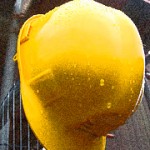Ed Pearl
If you have a giant stack of the best personal protective equipment (PPE), but dont use it, or just as important, dont use it properly, are you trying to become an OSHA statistic? Knowing how to protect yourself from occupational hazards is a critical part of your job.
A Real Life PPE Correction
A few years ago, I was taking my
annual HazWOPER 8-Hour Refresher class and a fellow student shared his story about PPE.
Part of his job was to open and close valves that allowed aviation fuels to flow to pumps used to fill airplane fuel tanks. As most of these valves were in confined space vaults without proper ventilation, he was often exposed to fuel vapors. After complaining about the headaches and dizziness that he was experiencing, his employer had him fit tested for a respirator. However, even with the proper-fitting respirator, he still had the same symptoms of overexposure.
Why didnt the respirator control the exposure? As a
health and safety professional, the answer was obvious to me! I asked him, What type of cartridge are you using?
His reply, I am using what was given to me. Two days later he called me to tell me that he had been given HEPA filters the WRONG cartridge for his petroleum vapors.
Instead he should have been using organic vapor cartridges. Without correction, this COULD have been become a very dangerous problem just because of the wrong cartridge in the right respirator.
Proper Protection: Where Do You Start?
A perfect place to start understanding how to protect yourself is to know what you are dealing with on the job.
- What are the potential hazards? Is there more than one? Not sure? Ask questions! Make sure that you understand the hazards and risk before you are satisfied?
- Are there chemicals? Read material safety data sheets (MSDS) which have standardized information required by OSHA. MSDSs for all chemicals at your worksite must be made available by your employer for your review. So that you, the worker, can read about the chemical hazards AND methods of protection. Its the law!
- Review your job duties and PPE with your job site safety officer or a health and safety professional.
Proper Protection: A Quiz
Q: If a person is working with an acid and they are wearing cloth gloves, who are they protecting?
A: Nobody! The proper glove is a chemical resistant polymer for protection from acids (usually a neoprene or polyvinyl chloride (PVC) glove). Depending on the risk of splash, this worker may also need goggles, a face shield, and chemical resistant garments (apron, or partial or full body protection).
Q: If a worker is welding and only wearing a face shield designed for grinding, are they properly protected?
A: Absolutely not! The proper protection for a welder includes a welding shield equipped with filter lenses that have a shade number appropriate for the welding operation
Q: What happens when you wear a respirator that is not properly fitted?
A: You are potentially letting in the very substance you are SUPPOSED to be protecting yourself from! OSHA mandates that all required use respirators be tested for proper fit using fit test procedures detailed in the OSHA Respirator standard (1910.134).
The point is, there is the right PPE for the job
know what it is, and use it correctly!
Proper Protection: Personal Responsibility
Today, information is at our fingertips on ALL subjects including PPE. Take the time to hunt around and find the information you need to properly protect yourself. There are all types of online courses and local resources including those provided by unions and insurance companies that welcome your questions and interest. Whether its the Internet or real, live health and safety professionals, ask questions to ensure that your PPE is right for you and the hazards you encounter. If you find out that dont have the proper PPE, dont do the job or youll eventually become an OSHA statistic or worse!












